History of Queen's University

Queen's History Outline Click Here
Queen's Heritage Study Click Here
John Austin Society Click Here
Refurbished Interior of part of Queen's College
(birthplace of Romanes 1848) Click Here
or see below:

Personal
Touch Kingston Life
Interiors, Spring 2012
(Reproduced with permission of the Editor - Jane
Deacon)
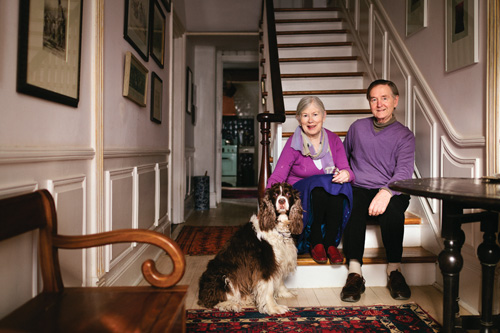
Homeowners: Patricia
and Donald Forsdyke
Location: Sydenham Ward
Size: 2,100 square feet
Years lived in: 30
by lindy mechefske
photography by tim forbes
Patricia and Donald Forsdyke's beautiful Sydenham Ward
townhouse has a remarkable pedigree. Kingston City Hall architect George Browne
designed and built the Georgian limestone in 1841 for his own use. One side was
his private dwelling and the other, his studio and office. In September 1844,
Queen's College, the predecessor of Queen's University, leased the building,
using one side for classes and the other as a preparatory school. In 1854,
Queen's moved to its new site, the present campus location, but continued to use
the limestone building until 1862.
It seems impossible to imagine, standing in the Forsdyke's gracious home, that
more than a century-and-a-half ago students would have gathered here for
lectures at the new college. Those students could scarcely have pictured a
modern lecture hall with professors wearing microphones, hundreds of students and electronic
gadgets of all descriptions. Remarkably, in 1844 when these students attended
their classes, Thomas Edison was still another three-and-a-half decades from
inventing the incandescent light bulb.
The Forsdykes have preserved the integrity of their home while adding their own
wonderful mix of English country and art-gallery-chic style for a house that
exudes functionality, history and a terrific sense of personality.

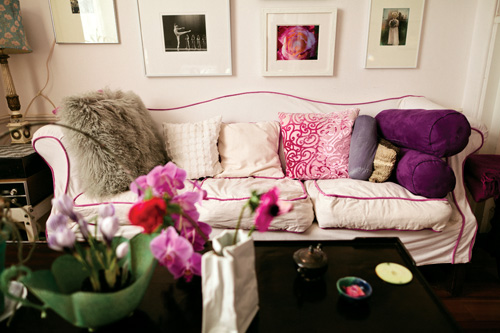

TOP: The living room
retains its Georgian details, while a Barcelona chair brings the look
up-to-date.
ABOVE: The gallery wall is adorned with images collected over many
years, with some pieces by their daughters.
What initially attracted you to the house?
We bought the house in 1982, after living in Cartwright Point. We were looking
for a place close to downtown, close to Queen's and KCVI. Our four daughters
were in various stages of schooling and this location just made sense for us. As
to the house itself, it simply needed saving. We loved its bones, the big
principal spaces - the ample living room for example, and the high windows. The
view of St. Mary's Cathedral from the back of the house was one of many charming
surprises.
When you bought your house, did you have a clear idea of what you wanted to do
with it? How has it transformed since then? Our most basic instinct was not
to destroy anything. We wanted to preserve and restore as much as possible of
the original Georgian style, although we also needed a functional family home.
Along the way we consulted both a local architect and a civil engineer, and did
a lot of research about the architecture of the era.
The house needed major repairs throughout. The wiring was turn-of-the-century,
the interior plaster was falling down, the roof was leaking, the foundation was
sagging, the plumbing was ancient and inadequate, the kitchen was antiquated,
the bathrooms needed overhauling, the floors had a definite slant, the garage
was still a horse shed, and one of the windows wells was stuffed with hay for
insulation. In short, it needed everything.
Our four daughters were delighted when we moved in because the early phase of
reconstruction meant six straight weeks of eating out.
How would you describe the current style of your home? Quite simply, it's
eclectic and timeless. We chose classic, well-made furniture and added fun
accents. The art was collected over many years. Some of the pieces were done by
our daughters, some we found, other pieces we bought at auction.
What was the ultimate design goal when redecorating your home? Preserving
the integrity of the house was paramount. The house is Georgian but was later
Edwardianized. One of the giveaways is the windows. The original windows would
have been a style called "six over six." These were later changed out,
destroying some of the original character. Other things like the stained glass
panels were added later too, but we've left them alone because they are
beautiful. Our goal was to respect the architecture while making the home fun
and liveable.
What was the greatest challenge of decorating your home? Renovating was a
bigger challenge than decorating. If we had it do all over, we'd choose not to
live in the house during the renovations, but that wasn't an option. We were
making so many decisions that we made a couple of blunders. For instance, we
fixed the plaster before realizing that one corner of the house needed to be
lifted, so then the plastering had to be redone, again. The decorating came
naturally, in layers, and with time.

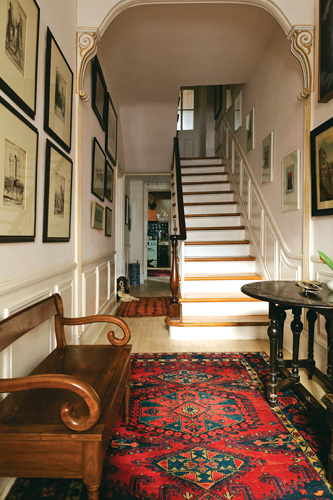
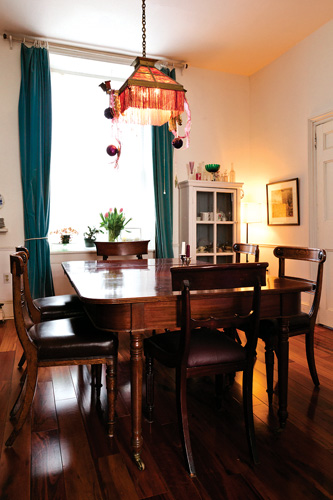
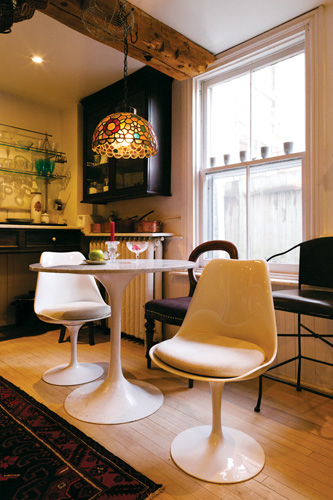
ABOVE: The kitchen is
a mixture of styles from mid-century modern to English country. The exposed
timber beam is not original to the house.
LEFT: The home's
grand entry is adorned with the couple's extensive art collection.
MIDDLE: The formal dining room mixes antique furnishings with bold
colours and an informal light fixture adds a bit of whimsy.
RIGHT: An original Eero Saarinen tulip table and chairs define the
breakfast nook. A classic stained glass pendant hangs above.
What is your biggest splurge item?
We're not good at compromising and have quite a list of splurge purchases, but
having the wood floors redone properly throughout was a huge splurge. Other
items include a spectacular vintage mirror purchased at the Cabin Fever Antique
Show, and incredibly funky white leather chairs from California.
What is your favourite room and why? We both love Donald's second-floor
study where we knocked a wall out and used two of the six bedrooms to make a
fabulous large space for all our books and family photographs. We also love the
kitchen, which is very English country.
What is your favourite piece? That's difficult, there are so many
favourites! The oversized sideboard in the dining room and the antique pine
table in the study both come to mind. We also love the custom woodwork we had
done by local craftsman, Eric Peters. But if we have to pick one favourite, it
would have to be the statue of Horatio Nelson that lives in the study. We saw
him at auction and resisted. But Nelson won, and after some effort we tracked
him down and managed to pick him up later. He's always been such good fun.
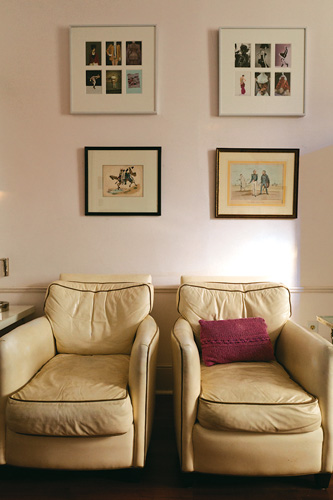


TOP LEFT: In the
living room sit two funky white leather chairs from California.
TOP RIGHT: The door on the upstairs bathroom was fitted with a piece of
stained glass from Balleycanoe & Co.
ABOVE: What was once two bedrooms now serves as a private study. The
Horatio Nelson statue was a lucky auction find.
Do you have a favourite bargain piece?
This would have to be the upstairs bathroom door. We purchased a lovely piece of
stained glass at Balleycanoe & Co., in Mallorytown. For years it lurked about,
with no purpose. Then we had the bright idea to use it in an interior door. It
is translucent so provides privacy, but the light shines through and the
colours, all the pinks and mauves, work with the rest of the house.
What do your friends say about your home? Some people thought we were quite
mad to take on such a project; the house was a wreck, there was a murder next
door just after we moved in, and we lived in a complete muddle during the
renovations. Now that is all long forgotten and what we hear is, "What a
charming home!"

Return to Romanes pages:
(Click Here)
Return to Homepage:
(Click Here)

Established April 2012 and last edited
11 November 2020 by Donald Forsdyke
![]()
![]()










